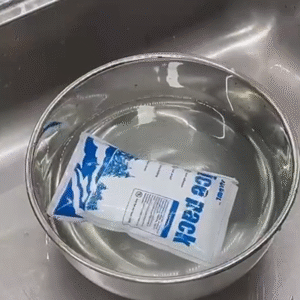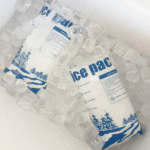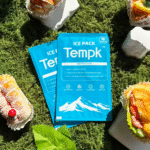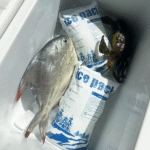Es ist nicht einfach, Produkte während des Fernversands gefroren aufzubewahren. A langlebige Trockeneis-Packfolie löst dieses Problem, indem es Ultra-Kälte bietet, tagelang auslaufsichere Kühlung, Nicht Stunden. Im Gegensatz zu normalen Gelpackungen, die schnell schmelzen, Diese Platten nutzen die Kraft der Sublimation von Kohlendioxid und Phasenwechselmaterialien (PCMs) 48–72 Stunden oder länger kalt bleiben. Sie halten Minustemperaturen aufrecht, ohne schmutziges Wasser zu hinterlassen, und sind einfach zu handhaben, Damit sind sie ideal für Arzneimittel geeignet, Biotech-Proben und Tiefkühlkost. In diesem Artikel wird erklärt, wie langlebige Trockeneisbeutel funktionieren, wie man das Richtige auswählt, Und was 2025 Innovationen bedeuten für Ihre Kühlkettenabläufe.
Was ist eine langlebige Trockeneis-Packfolie und wie funktioniert sie?? – Lernen Sie die Wissenschaft hinter Sublimation und PCMs kennen.
Wie wählen Sie das richtige Blatt für Ihre Sendung aus?? – Größenformeln verstehen, Behältervolumen und Umgebungsbedingungen.
Was sind die Vorteile gegenüber Gelpacks und PCMs?? – Temperaturen vergleichen, Langlebigkeit und Sicherheit.
Wie viel kosten sie und wie hoch ist der ROI? – Material bewerten, Bearbeitungs- und Regulierungskosten.
Welche Sicherheits- und Compliance-Regeln sollten Sie befolgen?? – Gehen Sie verantwortungsvoll mit CO₂ um und halten Sie sich an die UN 1845 Vorschriften.
Welche Innovationen treiben 2025 Trends? – Sensoren entdecken, nachhaltige Materialien und Hybridsysteme.
Was ist eine langlebige Trockeneisfolie und wie funktioniert sie??
Direkte Antwort
A langlebige Trockeneis-Packfolie ist eine flexible Platte, die mit komprimiertem Kohlendioxid gefüllt ist (Co₂) oder Phasenwechselmaterialien, die bei extrem niedrigen Temperaturen gefrieren. Bei Aktivierung, das Blatt sublimiert; Das Trockeneis geht direkt vom Feststoff in den gasförmigen Zustand über, Wärme absorbieren und eine kontrollierte kalte Umgebung aufrechterhalten. Hochwertige Platten können Produkte 48–72 Stunden lang zwischen –78,5 °C und –20 °C aufbewahren. Im Gegensatz zu Gelpackungen, die zu Flüssigkeit verschmelzen und an Wirksamkeit verlieren, diese Blätter bleiben trocken, Verringerung des Kontaminationsrisikos.
Ausführliche Erklärung
Denken Sie an a langlebige Trockeneis-Packfolie als kalte Batterie. Es nutzt zwei Technologien:
Komprimierter CO₂-Kern: Die inneren Zellen enthalten festes Kohlendioxid. Bei Kontakt mit der Umgebungsluft, Das Trockeneis untermüßt, große Mengen an Wärme aufnehmen. Dieser Prozess hält den Rucksack und die umgebende Ladung auf extrem niedrigen Temperaturen.
Phasenwechselmaterialien (PCMs): Einige Platten der nächsten Generation enthalten PCMs, die an bestimmten Minuspunkten gefrieren und schmelzen, typischerweise –20 °C bis –70 °C. Diese Materialien verändern sich langsam, Dadurch wird im Laufe der Zeit Kälteenergie freigesetzt und die Kühldauer verlängert.
Denn das Gas entweicht durch atmungsaktive Membranen, Es bleiben keine Flüssigkeitsrückstände zurück. Auch im gefrorenen Zustand bleiben die Platten flexibel, So können Sie sie um ungewöhnlich geformte Produkte wickeln, ohne die Verpackung zu beschädigen. Diese Flexibilität, kombiniert mit langen Haltezeiten, macht sie ideal für den Transport von Impfstoffen, Zellkulturen und Tiefkühlkost auf allen Kontinenten.
Kühlmechanismus und PCM vs. Trockeneis
Wärmespeicherung: Trockeneis-Packplatten für den nächsten Tag enthalten PCMs mit präzisen Gefrierpunkten. Sie nehmen während des Phasenübergangs Wärme auf und geben nach und nach Kälte ab. Im Gegensatz, Herkömmliches Trockeneis sublimiert schnell bei –78,5 °C, Eine sorgfältige Entlüftung ist erforderlich, um einen Druckaufbau zu vermeiden.
| Kühlmethode | Temperaturbereich | Typische Dauer | Praktische Bedeutung |
| Langlebige Trockeneis-Packfolie (CO₂-Kern) | –78,5 °C bis –20 °C | 48–72 h | Ultrakalte Sendungen wie Biotech-Proben, Impfstoffe und gefrorene Meeresfrüchte |
| PCM-Ziegel/Fliesen | –25 °C bis +25 °C | 24–96 h | Präzise Regelung für 2–8 °C oder Umgebungstemperaturbereiche; in klinischen Studien verwendet |
| Gel-/Eisbeutel | ~0 °C | 12–48 h | Kurztrips oder Gegenstände, die nicht einfrieren sollten; sie hinterlassen Wasserrückstände |
Praktische Tipps und Ratschläge
Vollständig aktivieren: Hydratieren Sie Polymerfolien oder nehmen Sie sie aus dem Lager, damit sie vor dem Einsetzen zu sublimieren beginnen. Durch Biegen des Blechs wird die Abkühlungsreaktion in Gang gesetzt.
Wickeln und verschließen: Richten Sie die Seiten und die Oberseite des Behälters aus, um eine 360°-Abdeckung zu gewährleisten. Kalte Luftwaschbecken; Vollständige Abdeckung verhindert warme Stellen.
Kombinieren Sie Technologien: Für extreme Haltezeiten, Wickeln Sie die Nutzlast mit langlebigen Trockeneisbeuteln ein und legen Sie darauf PCM-Steine. Diese Hybridmethode sorgt zunächst für extrem kalte Temperaturen und anschließend für eine gleichmäßige Abkühlung.
Fall aus der realen Welt: Ein Biotech-Unternehmen verwendete Folien der nächsten Generation für Notfallimpfstofflieferungen. Sie hielten eine Temperatur von –60 °C aufrecht 36 Stunden und reduzieren gleichzeitig die Bearbeitungskosten 25%.
So wählen Sie die richtige langlebige Trockeneis-Packfolie für Ihre Sendung aus?
Direkte Antwort
Das Recht wählen langlebige Trockeneis-Packfolie hängt vom Behältervolumen ab, Versanddauer und Umgebungsbedingungen. Als allgemeine Regel gilt ungefähr ein 24-Zellen-Blatt pro 5–8 Liter Innenvolumen 24 Std.. Erhöhen Sie die Blattanzahl für längere Zeiträume oder heißere Klimazonen; Jedes Blatt verlängert die Kühlhaltezeit um 8–12 Stunden. Kühlen Sie Ihre Verpackung und Nutzlast vor, um die Leistung zu maximieren.
Detaillierte Dimensionierung und Bewertung
Berechnen Sie Volumen und Dauer: Verwenden Sie die Formel Blätter = Decke(Volumen_L / 7). Fügen Sie ein Blatt hinzu, wenn die Route länger ist 24 Std., wenn die Umgebungstemperatur hoch ist oder Ihre Isolierung dünn ist.
Passen Sie den Blatttyp dem Produkt an: Blätter, die in der Nähe abkühlen 0 °C sind ideal für gekühlte Waren (0–8 ° C). Für Sendungen unter –20 °C eignen sich festes Trockeneis oder Hybridkombinationen besser.
Berücksichtigen Sie die Qualität der Isolierung: Dichter EPS-Schaum ermöglicht einen geringeren Trockeneisverbrauch (5 Pfund pro 24 H), während Pappeinlagen mehr Blätter erfordern.
Berücksichtigen Sie die Umwelt: Fügen Sie für jedes weitere ein Blatt hinzu 10 °C Anstieg der Umgebungstemperatur oder für jeden zusätzlichen Transittag.
Empfohlene Packout-Tabelle
| Behältervolumen (L) | Startblätter | Typischer Halt (gekühlt) | What It Means for You |
| 5–10 | 1 Blatt | 8–24 h | Kompakte Kartons oder kleine Versandtaschen |
| 15–20 | 2–3 Blatt | 24–48 h | Die meisten DTC-Lebensmittel- oder Pharmapakete |
| 25–30 | 3–4 Blatt | 36–60 h | Große Nutzlasten erfordern zusätzlichen Spielraum |
| 40+ | 4–6 Blätter | 48–72 h | Verlängerte Fahrspuren oder warmes Klima |
Praktische Tipps und Ratschläge
Verwenden Sie einen Größenrechner: Implementieren Sie auf Ihrer Website ein interaktives Tool, das die Anzahl der Blätter anhand der Behältergröße berechnet, Dauer und Umgebungstemperatur. Dies reduziert das Rätselraten und verbessert die Packungskonsistenz.
Konditionieren Sie den Versender vorab: Frieren Sie die Platten 24–48 Stunden lang flach bei ≤ –18 °C ein und kühlen Sie sowohl das Produkt als auch den Versandkarton vor.
Mit einem Prüfstandstest validieren: Führen Sie einen 6–8-stündigen Test in einer kontrollierten Umgebung durch (23 ° C Umgebung, 2–8 °C Nutzlast) um die Blattleistung zu bestätigen.
Tatsächlicher Fall: Eine Marke für Essenssets hat die Wrap-and-Cap-Verpackung mit 24 Zellblättern eingeführt und die Probleme bei der Ankunft bei warmem Sommerwetter um ein Drittel reduziert.
Vorteile der Verwendung langlebiger Trockeneis-Packplatten gegenüber anderen Kühlmethoden
Direkte Antwort
Langlebige Trockeneis-Packplatten sorgen für kältere Temperaturen, längere Haltezeiten und saubererer Betrieb als Gel- oder PCM-Packs. Sie halten 48–72 Stunden lang eine Temperatur von –78,5 °C bis –20 °C und hinterlassen keine Wasserrückstände. Durch Wiederverwendbarkeit und Flexibilität sind sie kostengünstig und für verschiedene Sendungen anpassbar.
Detaillierter Vergleich und Vorteile
Erweiterte Langlebigkeit: Jedes Blatt bietet 8–12 Stunden Kühlleistung; Durch die Kombination mehrerer Blätter verlängert sich die Haltbarkeit auf 48–72 Stunden.
Niedrigere Temperaturen: Trockeneisplatten erzeugen viel kältere Temperaturen als Gelpackungen oder PCMs, Sicherstellung, dass Impfstoffe, Enzyme und Tiefkühlkost bleiben im erforderlichen Zustand.
Kein Restwasser: Denn Trockeneis sublimiert direkt zu Gas, Es gibt keine Flüssigkeitsrückstände, die die Sendung verunreinigen könnten.
Wiederverwendbarkeit: Viele Trockeneisplatten auf Polymerbasis können für mehrere Zyklen rehydriert und wieder eingefroren werden, Reduzierung von Abfall und Kosten pro Sendung.
Flexibel und sicher: Die Blätter passen sich unregelmäßigen Formen an und reduzieren den Papieraufwand für gefährliche Stoffe im Vergleich zu festem CO₂, wodurch sie einfacher zu handhaben und zu versenden sind.
Gel- und PCM-Vergleich
| Faktor | Gel-/Eisbeutel | Langlebige Trockeneis-Packblätter | What It Means for You |
| Temperaturbereich | 0 °C | –78,5 °C bis –20 °C | Trockeneisplatten gefrieren Produkte zuverlässiger |
| Zeit halten | 6–24 h | 48–72 h | Weniger Auspacken und geringere Gefahr des Auftauens |
| Rückstand | In Wasser schmelzen (Gefahr von Feuchtigkeitsschäden) | Sublimates zu Gas (Keine Flüssigkeit) | Sauberere Sendungen |
| Sicherheit | Geringe Gefahren, aber begrenzte Kühlung | Erfordert Belüftung und Handschuhe | Den Umgang mit CO₂ verstehen und verwalten |
Praktische Tipps und Ratschläge
Für ultrakalte Sendungen verwenden: Wählen Sie langlebige Trockeneis-Packplatten, wenn Sie Produkte länger als gefroren aufbewahren müssen 24 Std., wie zum Beispiel grenzüberschreitende Lieferungen von Impfstoffen oder Meeresfrüchten.
Hybride Strategien: Für Sendungen, die sowohl Gefrieren als auch kontrollierte Kühlung erfordern, Kombinieren Sie Trockeneisplatten mit PCM-Steinen. Das Trockeneis bewältigt die Tiefkühlung, während PCMs während des letzten Teils der Reise eine konstante Temperatur von 2–8 °C aufrechterhalten.
Erwägen Sie PCMs für CRT-Bereiche: Beim Versand bei 15–25 °C oder 15–30 °C, Gele auf Wasserbasis sind leistungsschwach, während PCMs 5- bis 10-mal mehr latente Wärme liefern und das Gewicht reduzieren. Verwenden Sie eine Trockeneisplatte nur, wenn extrem niedrige Temperaturen erforderlich sind.
Fall aus der realen Welt: Ein Speziallebensmittelhändler ersetzte am nächsten Tag Blocktrockeneis durch Trockeneisplatten und berichtete 45% weniger temperaturbedingte Verluste und 30% weniger Dokumentationszeit
Kostenüberlegungen und ROI für langlebige Trockeneis-Packplatten
Direkte Antwort
Obwohl langlebige Trockeneis-Packplatten kann im Voraus mehr kosten, Ihre Wiederverwendbarkeit und Effizienz reduzieren die langfristigen Kosten. Dank geringerer Bearbeitungskosten erzielen Unternehmen innerhalb von 4 bis 8 Monaten einen Return on Investment, weniger Produktverluste und vereinfachte Einhaltung gesetzlicher Vorschriften.
Detaillierte Kostenanalyse
Mehrere Faktoren tragen zu den Gesamtbetriebskosten bei:
Materialkosten: Herkömmliches Trockeneis muss bei jeder Lieferung ersetzt werden, wohingegen die Kosten für wiederverwendbare Tücher mit der Zeit pro Sendung sinken.
Bearbeitungskosten: Festes CO₂ erfordert eine spezielle Ausbildung; Polymerplatten folgen Standardverfahren, Senkung der Arbeitskosten.
Vorschriftenregulierung: Trockeneis gilt als Gefahrstoff. Als ungefährlich eingestufte Blätter vereinfachen den Papierkram und reduzieren Verzögerungen.
Produktverlustrisiko: Sublimation und ungleichmäßige Kühlung mit Blockeis können zum Verderb führen. Blätter sorgen für eine kontrollierte Leistung und geringere finanzielle Abschreibungen.
Kostenvergleichstabelle
| Kostenkomponente | Traditionelles Trockeneis | Langlebige Trockeneis-Packfolie | Warum ist es wichtig |
| Materialkosten pro Sendung | Hoch (einmaliger Gebrauch) | Nimmt bei Wiederverwendung ab | Geringere langfristige Ausgaben |
| Bearbeitungskosten | Spezielle Schulung erforderlich | Standardhandhabung | Reduzierte Arbeitskosten |
| Regulatorischer Papierkram | Bedeutsam | Minimal | Zeitersparnis |
| Produktverlustrisiko | Höher durch Sublimation | Kontrollierte Leistung | Weniger Abschreibungen |
Strategien zur Budgetoptimierung
Verhandeln Sie Mengenpreise: Für hochvolumige Operationen, Verhandeln Sie mit Lieferanten, um die Stückkosten zu senken und gleichzeitig die Qualität aufrechtzuerhalten.
Verfolgen Sie die Nutzung: Implementieren Sie eine abteilungsübergreifende Nutzungsverfolgung, um Verschwendung zu identifizieren und die Blattanzahl zu optimieren.
Planen Sie saisonal: Erstellen Sie fortlaufende Prognosen, die saisonale Versandmengen berücksichtigen, um Überbestellungen zu vermeiden.
Fall aus der realen Welt: Ein Logistikunternehmen für klinische Studien stellte auf langlebige Trockeneis-Packfolien um und reduzierte die Gesamtkosten der Kühlkette um 40%, Dies liegt vor allem an der geringeren Bearbeitungszeit und dem Wegfall der Gefahrstoffgebühren
Sicherheit und Konformität: Ordnungsgemäße Handhabung und behördliche Richtlinien
Direkte Antwort
Bei der Verwendung steht die Sicherheit an erster Stelle langlebige Trockeneis-Packplatten. Tragen Sie immer isolierte Handschuhe und Schutzbrillen, Sorgen Sie für eine ausreichende Belüftung, damit das CO₂-Gas entweichen kann, und befolgen Sie Versandvorschriften wie UN 1845 und HIER PI 954. Wiederverwendbare Polymerplatten sind sicherer in der Handhabung als Trockeneisblöcke, Die richtige Vorbereitung und Kennzeichnung bleibt jedoch von entscheidender Bedeutung.
Detaillierte Sicherheitshinweise
Trockeneis ist extrem kalt (–78,5 °C) und sublimiert ungefähr 10 lbs pro 24 Stunden in einem Standard-Isolierbehälter. Um Verletzungen und Regelverstößen vorzubeugen:
Persönliche Schutzausrüstung: Verwenden Sie kryogene Handschuhe, lange Ärmel, und Augenschutz beim Umgang mit Blättern oder festem Trockeneis. Vermeiden Sie direkten Hautkontakt, um Erfrierungen vorzubeugen.
Belüftung: Versiegeln Sie niemals Trockeneis in einem luftdichten Behälter; Sublimierendes Gas benötigt einen Fluchtweg, um einen Druckaufbau zu verhindern.
Kennzeichnung und Dokumentation: Bei Verwendung von festem CO₂, Kennzeichnen Sie Pakete mit „Trockeneis“ und dem Nettogewicht (Und 1845) und befolgen Sie die Richtlinien der Fluggesellschaft oder Fluggesellschaft.
Sichere Aufbewahrung: Bewahren Sie Trockeneis in isolierten Behältern mit harten Seiten auf und füllen Sie den leeren Raum mit Papier, um die Sublimation zu verlangsamen.
Fachgerechte Entsorgung: Lassen Sie übrig gebliebenes Trockeneis an einem gut belüfteten Ort sublimieren. Nicht in die Kanalisation oder luftdichte Räume entsorgen.
Hilfreiche Tipps
Personal schulen: Entwickeln Sie klare Standardarbeitsanweisungen (Sops) zur Feuchtigkeitsversorgung, Einfrieren, Packen und Belüften von Trockeneisplatten.
Verwenden Sie Sensoren: Integrieren Sie Temperatursensoren oder IoT-Geräte, um die Blechleistung zu überwachen und Abweichungen zu erkennen.
Compliance weltweit: Die Klassifizierung als nicht gefährlich vereinfacht den internationalen Versand, Aber überprüfen Sie immer die länderspezifischen Regeln.
Notiz: Der Missbrauch von Trockeneis kann zu einem explosionsartigen Druckaufbau oder zur Erstickung führen. Befolgen Sie stets die Vorschriften für einen sicheren Versand und eine sichere Entsorgung.
2025 Trends und Innovationen bei langlebigen Trockeneis-Packplatten
Direkte Antwort
In 2025 Die langlebige Trockeneis-Packfolie Der Markt entwickelt sich rasant. Hersteller fügen intelligente Sensoren für die Temperaturüberwachung in Echtzeit hinzu, Entwicklung umweltfreundlicher Materialien, Umsetzung von Recyclingprogrammen, und die Kombination von Trockeneis mit PCMs in Hybridsystemen. Nachfrage nach Smarter, nachhaltiger und digital integrierter Lösungen wächst um ca 20% jährlich.
Trend-Highlights
Integrierte Überwachungssysteme: Die Platten der nächsten Generation verfügen über eingebettete Sensoren, die Temperaturdaten an Logistikplattformen übermitteln. Dies ermöglicht ein proaktives Eingreifen, wenn Sendungen von den Sollpunkten abweichen.
Fortgeschrittene Materialwissenschaft: Neue PCM-Formulierungen bieten größere Temperaturbereiche, ohne dass Größe oder Gewicht zunehmen. Hybrid-Setups kombinieren Trockeneis mit PCMs, um sowohl ultrakalte als auch kontrollierte Kühlung bereitzustellen.
Nachhaltigkeitsinitiativen: Hersteller verwenden recycelte Materialien und erstellen Rücknahmeprogramme für Altpapiere. Biotech-Platten werden mit geringerem CO2-Fußabdruck und energieeffizienten Methoden hergestellt.
Präzise Sublimationskontrolle: Verbesserungen im Blattdesign reduzieren den CO₂-Verlust auf 3–8 % pro Tag, Steigerung der Effizienz.
Marktwachstum: Der Kühlkettenmarkt wächst 15% jährlich, mit fast 40% Wachstumspotenzial in Nordamerika. Intelligentere Kühllösungen differenzieren Marken und verbessern die Kundenzufriedenheit.
Practical Tips
Führen Sie Smart Sheets ein: Verwenden Sie IoT-fähige Blätter, um die Temperatur zu überwachen und Warnungen zu automatisieren, wenn Grenzwerte überschritten werden.
Beteiligen Sie sich am Recycling: Arbeiten Sie mit Lieferanten zusammen, die Rücknahmeprogramme oder Laken aus recycelbaren Materialien anbieten.
Entdecken Sie Hybrid-Packouts: Kombinieren Sie langlebige Trockeneis-Packplatten mit PCMs für Sendungen, die sich durch mehrere Temperaturzonen bewegen.
Einblicke in die Branche: Unternehmen, die Validierungsprotokolle und Sensoren implementieren, haben den Verderb um 30–60 % reduziert und gleichzeitig den Abfall reduziert.
Markteinblicke und zukünftige Entwicklung
Wachstumstreiber
E-Commerce-Erweiterung: Der Online-Verkauf verderblicher Waren erfordert zuverlässige Kühlkettenlösungen. Dieses Wachstum treibt Innovationen bei langlebigen Trockeneis-Packplatten voran und drängt Unternehmen dazu, bessere Leistung und Nachhaltigkeit anzubieten.
Regulierungsdruck: Strengere Richtlinien für den Pharmaversand erfordern eine präzise Temperaturkontrolle. Nicht gefährliche Blätter vereinfachen die Einhaltung und reduzieren Verzögerungen.
Nachhaltigkeitsanforderungen: Verbraucher erwarten umweltfreundliche Verpackungen. Platten der nächsten Generation reduzieren den CO2-Fußabdruck um etwa 10 % 30% im Vergleich zu 2024 Lösungen.
PCMs & Hybridsysteme: PCMs speichern 5–10 Mal mehr Energie als Gele auf Wasserbasis, Dies ermöglicht leichtere Sendungen und senkt die Frachtkosten.
Strategische Überlegungen
Investieren Sie in Technologie: Weisen Sie Budget für sensorfähige Blätter zu, Datenintegration und -analyse zur Optimierung von Kühlkettenabläufen.
Planen Sie globales Wachstum: Da die Nachfrage in Nordamerika und weltweit steigt, Sichern Sie Lieferketten und diversifizieren Sie Lieferanten, um Engpässe zu vermeiden.
Informieren Sie Ihre Kunden: Erklären Sie die Vorteile langlebiger Trockeneis-Packplatten, einschließlich Sicherheit und Nachhaltigkeit, um Vertrauen aufzubauen und Ihre Marke zu differenzieren.
Häufig gestellte Fragen
Q1: Wie lange hält eine langlebige Trockeneis-Packfolie??
Die meisten Platten halten bei richtiger Vorbereitung und Isolierung die extrem kalten Temperaturen 48–72 Stunden lang aufrecht. Hochleistungsversionen mit mehreren Blättern oder Hybrid-Setups können die Haltezeiten verlängern 72 Stunden und darüber hinaus.
Q2: Sind langlebige Trockeneisbeutel wiederverwendbar??
Ja. Folien auf Polymerbasis können für mehrere Sendungen hydratisiert und wieder eingefroren werden. Überprüfen Sie stets, ob Löcher vorhanden sind, und befolgen Sie die Richtlinien des Herstellers zum Wiedereinfrieren.
Q3: Ist eine Trockeneis-Packfolie das Gleiche wie festes Trockeneis??
NEIN. Eine Trockeneis-Packfolie ist eine Decke auf Polymer- oder PCM-Basis, die die Umgebung kühlt 0 °C, wohingegen festes Trockeneis reines CO₂ ist, das –78,5 °C erreicht. Die Laken sind flexibel und ungefährlich; Festes Trockeneis erfordert eine besondere Kennzeichnung und Entlüftung.
Q4: Wie soll ich eine langlebige Trockeneis-Packfolie entsorgen??
Lassen Sie das verbleibende Trockeneis in einem belüfteten Bereich sublimieren. Für Polymerplatten, Befolgen Sie die Recycling- oder Entsorgungsanweisungen des Lieferanten.
Q5: Kann ich mit Trockeneis-Packplatten fliegen??
Die meisten Fluggesellschaften erlauben bis zu 2.5 kg (5.5 lb) Trockeneis pro Passagier, sofern die Verpackungen belüftet und gekennzeichnet sind. Informieren Sie sich vor dem Flug über die spezifischen Regeln und Sicherheitsrichtlinien der Fluggesellschaft.
Zusammenfassung und Empfehlungen
Langlebige Trockeneis-Packplatten halten Ihre Sendungen tagelang extrem kalt, ohne dass es zu schmelzendem Eis kommt. Sie verwenden komprimiertes CO₂ und PCM, um Temperaturen von –78,5 °C bis –20 °C für 48–72 Stunden aufrechtzuerhalten. Richtige Größe (ein Blatt pro 5–8 l pro Tag), Vorkonditionierungs- und Hybridstrategien sorgen für eine konstante Leistung. Im Vergleich zu herkömmlichen Gelpackungen, Diese Laken sorgen für kältere Temperaturen, längere Lebensdauer und saubererer Betrieb. Die anfänglichen Kosten scheinen zwar höher zu sein, Unternehmen amortisieren ihre Investition innerhalb weniger Monate durch Wiederverwendbarkeit, einfachere Handhabung und geringerer Verderb. 2025 Trends – intelligente Sensoren, Nachhaltige Materialien und Hybridsysteme – machen Sie dies zum idealen Zeitpunkt für die Modernisierung Ihrer Kühlkettenverpackung.
Umsetzbare Anleitung
Bewerten Sie Ihre Spur: Bewerten Sie das Behältervolumen, Dauer und Umgebungsbedingungen. Verwenden Sie einen Größenrechner, um die Anzahl der benötigten Blätter zu ermitteln.
Implementieren Sie SOPs: Schulung des Personals zum Thema Flüssigkeitszufuhr, Einfrieren, Wrap-and-Cap-Verpackung und Entlüftung. Verwenden Sie IoT-Sensoren, um die Temperatur während des Transports zu überwachen.
Investieren Sie in Innovation: Wählen Sie Platten aus nachhaltigen Materialien und integrieren Sie eine Echtzeitüberwachung. Hybrid-Setups mit PCMs bieten eine hervorragende Kontrolle über verschiedene Temperaturzonen hinweg.
Planen Sie den ROI: Verfolgen Sie Einsparungen durch geringere Ausschuss- und Bearbeitungskosten. Viele Unternehmen amortisieren ihre Investition innerhalb von 4–8 Monaten.
Über Tempk
Tempk ist ein führender Anbieter fortschrittlicher Kühlkettenlösungen. Wir entwickeln und validieren langlebige Trockeneis-Packplatten, PCMs und Hybridkühlsysteme für Lebensmittel, Pharmazeutika und Biotechnologie. Unser 2025 Innovationen integrieren IoT-Sensoren, recycelte Materialien und anpassbare Phasenwechselpunkte sorgen für ultrakalte Leistung bei minimalem Abfall. Mit Fokus auf Sicherheit und Nachhaltigkeit, Wir helfen unseren Kunden bei der Einhaltung der UN 1845 und IATA-Vorschriften bei gleichzeitiger Reduzierung von Kosten und CO2-Fußabdruck. Konsultieren Sie noch heute unsere Spezialisten eine maßgeschneiderte Kühlstrategie zu entwickeln, die die Sicherheit Ihrer Produkte und die Effizienz Ihres Betriebs gewährleistet.
























